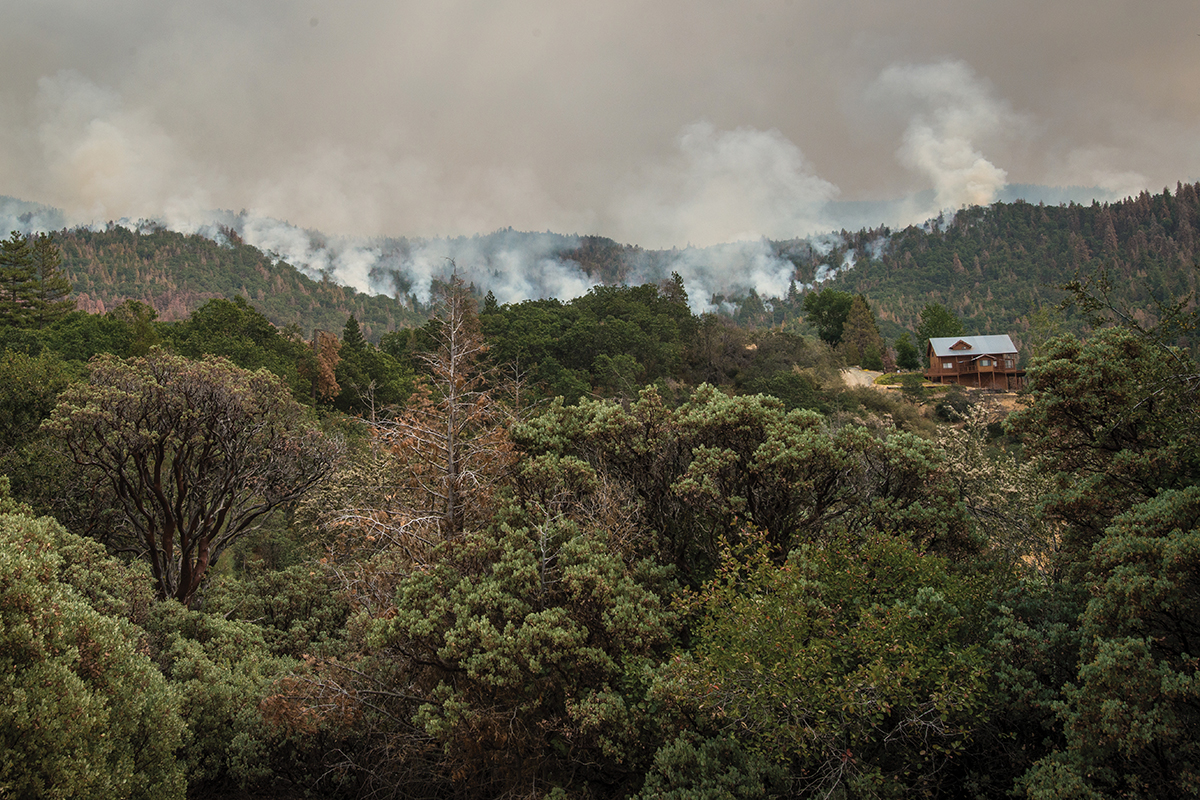This special issue of PERC Reports explores the thorny issues of forest management, wildfire mitigation, and regulatory reform. Read the full issue.
Does more public spending to suppress wildfires subsidize development in harm’s way? Economist Judson Boomhower has found evidence in the affirmative.
Boomhower is an assistant professor in the Department of Economics at the University of California, San Diego, and was a 2019 Lone Mountain Fellow at PERC, where he studied this very question. In recently published research, Boomhower and his co-author Patrick Baylis examined how federal and state wildfire policies can create what economists call “moral hazard.” We asked Boomhower about wildfire risk, the consequences of moral hazard in fire policy, and potential ways to improve the status quo.
What exactly do economists mean by moral hazard, and how does it apply in the context of wildfires?
In the case of wildfires, it’s easiest to think about this as a disconnect between who makes decisions and who bears the costs. Decisions about home building in high fire-hazard areas are usually made by local governments and individuals. But the institutional arrangement of wildland firefighting in the United States means that a big share of the cost of protecting those homes falls on federal and state agencies. That includes several billion dollars per year spent battling wildfires that threaten homes and other private property.
That disconnect raises the possibility that, in some cases, development might proceed differently if local decision makers fully internalized the costs of protecting these homes from fire. That could be true both for where homes are built and how they are built, in terms of how much is invested in making structures and communities fire-resistant.
Is this an issue across the West, or only in particular places?
Wildfire risk is an issue throughout the West, and increasingly in other parts of the United States as well. There are millions of homes in the so-called wildland-urban interface, and they are spread across all western states. However, that risk is very much not uniform across space. Certain high-hazard areas are particularly likely to face large, dangerous wildfires. Scientists have made lots of progress in modeling fire hazard at a granular spatial scale, which gives us a pretty good picture of where the highest-risk areas are.
How much of an implicit subsidy are homeowners getting from the expectation that government agencies will aggressively suppress fires near homes?
The amount that taxpayers are essentially transferring to homeowners, through expenditures on wildfire suppression, really varies quite a bit across locations. Patrick Baylis and I have done some research on this question. We find that, in extreme cases, it can be more than 20 percent of a home’s value—often tens of thousands of dollars across the lifetime of a home.
Two important determinants are the physical fire hazard and the local density of development. In more densely developed areas, the costs of fighting a fire are essentially divided across a larger number of homes. So the really large implicit subsidies end up being for very sparsely developed communities in fire-prone areas.
Our calculation also omits some important costs, like money spent by utilities to prevent ignitions from electricity-distribution infrastructure that carries power to homes in high-hazard areas. For that reason, we think our numbers are likely conservative.
What effects does this dynamic have beyond the individual homeowner?
Local government decisions about land use and zoning are important determinants of where construction takes place. In many states, local governments also have an important role in determining wildfire building codes. In another recent study, we find that those code decisions are quite important in determining community resilience to wildfires. And fire managers have long argued that hardening homes in this way could reduce the burden on firefighters during wildfire emergencies.
Another salient issue here is that any one home’s wildfire risk depends not only on individual investments but also on community factors. How to coordinate these neighborhood and community-level investments in fire protection is an important issue.
As fires continue to become more costly and deadly, more political attention is being devoted to the need to reduce wildfire risk. What recommendations would you make to help resolve the wildfire policy moral hazard?
The rapid intensification of wildfire risk in recent years has highlighted a lot of policy challenges around wildfires in the United States. The moral hazard issue we’ve been discussing is an important one, but there are also many others: difficult questions about insurance market regulation, legal liability for utility-caused wildfires, health impacts from wildfire smoke, and political questions about agency funding, just to name a few. The growth that we’re seeing in this risk underscores the importance of addressing all of these challenges. Thinking specifically about implicit subsidies for risky development, a classic economic solution would be to realign incentives through development fees or other mechanisms so that decision makers internalize the fire-protection costs of new development.
Are there ways to encourage people to make safer decisions about where to build?
Some of my colleagues in economics have done nice research documenting how homeowners in high fire-hazard areas often do not appreciate the risk that they face from wildfires. This is yet another “market imperfection” that seems important in this area, and it suggests that there may be scope for pure information interventions—for example, development of public-facing risk prediction tools like the U.S. Forest Service Wildfire Risk to Communities initiative. We’ve also seen some jurisdictions introduce disclosure requirements for wildfire risk at the time of a property sale.
What could policymakers do to decrease risk where fire-prone areas have already been developed with homes and other construction?
This is a really hard, and really important, question. The existing stock of vulnerable homes in high fire-hazard areas will be an issue for decades to come. There are several margins for private or public investment. The urgent question is how to balance resources and effort across these approaches. Some investments can reduce the likelihood of property damage, such as hardening homes—for example, installing vent covers or replacing wood roofs—and vegetation management to reduce fuel.
An equally important goal is to ensure that homeowners are able to protect themselves financially in the event that they do experience a wildfire loss. That means trying to ensure the efficient operation of private insurance markets. It also means public support for fire victims in some cases.
What role should private property owners in fire-prone areas play?
I think most economists would agree that the homeowners insurance market has an important role to play here. In theory, well-functioning insurance markets should provide property owners with price signals to guide mitigation investments. Actions that reduce a property’s wildfire risk would reduce insurance premiums commensurately. The reality of property insurance is considerably more complicated for both economic and political reasons. Still, to the extent that these markets can be organized in a way that preserves this basic idea of risk-based pricing, that is an important thing to do.




